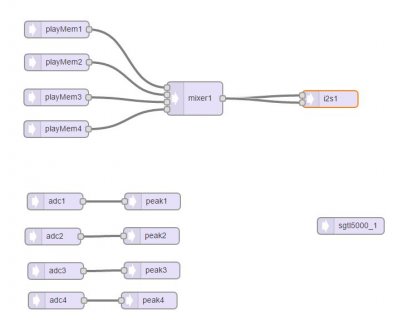I am trying to build a (very basic) drum module using teensy (3.1) and the audio shield
this is my setup :

where each piezo is connected to on an analog pin mediated by the adc-s. However I found out that
having more than one AudioInputAnalog is impossible (the program compiles but there is no sound).
My question is whether it is even appropriate to use the teensy+audio shield for this purpose ?
My thoughts are that the inputs from the drum pads are simple velocity inputs and not high definition
audio inputs as perhaps intended by the audio shield so there might be some way to convey
these inputs perhaps without using AudioInputAnalog ? Any help would be appreciated.
this is my setup :

where each piezo is connected to on an analog pin mediated by the adc-s. However I found out that
having more than one AudioInputAnalog is impossible (the program compiles but there is no sound).
My question is whether it is even appropriate to use the teensy+audio shield for this purpose ?
My thoughts are that the inputs from the drum pads are simple velocity inputs and not high definition
audio inputs as perhaps intended by the audio shield so there might be some way to convey
these inputs perhaps without using AudioInputAnalog ? Any help would be appreciated.


